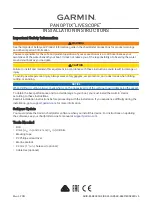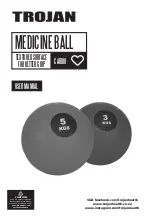
Form No. HCSRM-0817
23
English
MAINTENANCE
Cleaning the Stone Surface
(HCSSBR, HCSSBFR, HCSSBX, and
HCSSBFX Models)
Proper use of the products listed below will not damage the
stone shelf (follow the directions on the product labels).
NOTE: Stone surfaces are a simulated stone solid surface.
CAUTION
After deep cleaning stone surface using abrasives, make
sure to clean and sanitize surface properly before placing
food product.
IMPORTANT NOTE
Bottom-mounted units are installed with a bead of silicone
sealant between the unit and the countertop. Use caution
when cleaning with the abrasive pad and avoid contact with
the silicone sealant.
Hard to Remove Stains
For hard-to-remove stains, use the supplied abrasive pad
along with an abrasive cleaner such as Ajax, Comet, Bon Ami,
Magic Scrub, or Bar Keeper’s Friend. Additional abrasive pads
are available from Hatco (P/N 04.39.049.00).
NOTICE
: Use
supplied abrasive pad on stone surface only.
NOTE: Do not use steel wool or metal scouring pads.
Mineral Based Stains
For a mineral-based stain, cleaners designed to remove iron or
rust are recommended and should not harm the stone surface.
Scratches
For scratches, use sandpaper starting with the coarsest grit and
going to finest grit until the scratch disappears. Blend area in
with the supplied abrasive pad.
Monthly Cleaning
Perform the following procedure monthly to maintain proper
and efficient operation as well as prevent malfunction of the
condensing unit.
1. Remove and clean both sides of the louvered or grill-style
panels that are installed in the ventilation openings. Dirt
and dust build-up in the panels can restrict air flow to the
condensing unit and cause over-heating.
2. Clean the condenser coil cooling fins. Dirt, dust, and lint
build-up in the cooling fins will prevent proper cooling of
the refrigerant in the refrigeration system. This build-up will
cause inefficient operation and can lead to unit failure. Use
the following methods to clean the condenser coil cooling
fins:
• Vacuum the cooling fins.
• Brush the cooling fins vertically using a condenser
coil brush.
NOTICE
: Use caution when brushing
the cooling fins, they are delicate and can be bent
easily. DO NOT use a wire brush.
Condenser Coil
Cooling Fins
Condenser Coil Cooling Fins
NOTE: Depending on the conditions of the installation site, this
cleaning procedure may need to be performed more
often or less often than monthly. Monitor the level of dirt,
dust, and lint buildup on the panels and cooling fins,
and make adjustments to the frequency of cleanings as
necessary.
















































